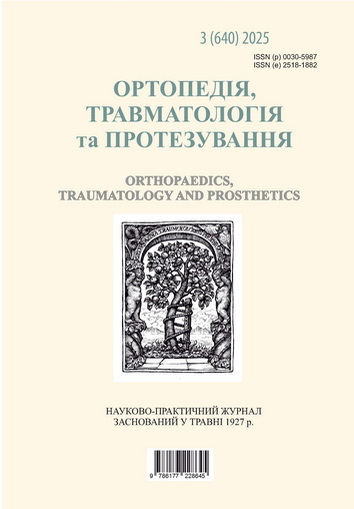EVALUATION OF THE EFFICACY OF KINEMATIC AND MECHANICAL ALIGNMENT IN PRIMARY TOTAL KNEE ARTHROPLASTY DURING THE EARLY POSTOPERATIVE PERIOD
DOI:
https://doi.org/10.15674/0030-59872025353-60Keywords:
Кinematic alignment, mechanical alignment, total knee arthroplasty, knee jointAbstract
Mechanical alignment is widely accepted as a standard technique for total knee arthroplasty (TKA). However, approximately 20 % of patients remain dissatisfied with the outcomes. Recent studies suggest that an alternative method, known as kinematic alignment, could potentially improve functional outcomes and provide more rapid pain relief during the early postoperative period. Objective. To compare early postoperative clinical and functional outcomes of primary total knee arthroplasty performed using either kinematic or mechanical alignment. Methods. We prospectively analyzed the outcomes of 100 patients undergoing primary TKA, with 50 patients receiving mechanical alignment and 50 receiving kinematic alignment. Clinical assessments included pain measurement using the VAS, functional evaluation using the WOMAC, and knee range of motion (ROM). Assessments were conducted preoperatively, at 14 days, and 1.5 months postoperatively. Results. Analysis of key surgical parameters — including operation duration, intraoperative blood loss, and length of hospital stay — revealed no significant differences between the two groups. However, the requirement for additional ligament releases was significantly higher in the mechanical alignment group. According to WOMAC scores, the kinematic alignment group showed consistently better outcomes at all follow-up stages. At postoperative day 14, the kinematic alignment group had significantly better VAS pain scores and greater knee ROM compared to the mechanical alignment group (p < 0.05). However, by 1.5 months after surgery, the differences between the two groups were no longer statistically significant (p > 0.05). Conclusions. Kinematic alignment leads to superior early pain relief and faster functional recovery in the initial postoperative period compared to mechanical alignment. Nevertheless, differences in pain and function between both groups diminish by 1.5 months after surgery. These findings suggest the need for further studies with a longer follow-up (at least one year) to evaluate long-term outcomes and potential complications.
Downloads
How to Cite
Issue
Section
License
Copyright (c) 2025 Mykola Moroz, Roman Kozak, Oleh Kostogryz, Volodymyr Bondar

This work is licensed under a Creative Commons Attribution 4.0 International License.
The authors retain the right of authorship of their manuscript and pass the journal the right of the first publication of this article, which automatically become available from the date of publication under the terms of Creative Commons Attribution License, which allows others to freely distribute the published manuscript with mandatory linking to authors of the original research and the first publication of this one in this journal.
Authors have the right to enter into a separate supplemental agreement on the additional non-exclusive distribution of manuscript in the form in which it was published by the journal (i.e. to put work in electronic storage of an institution or publish as a part of the book) while maintaining the reference to the first publication of the manuscript in this journal.
The editorial policy of the journal allows authors and encourages manuscript accommodation online (i.e. in storage of an institution or on the personal websites) as before submission of the manuscript to the editorial office, and during its editorial processing because it contributes to productive scientific discussion and positively affects the efficiency and dynamics of the published manuscript citation (see The Effect of Open Access).














